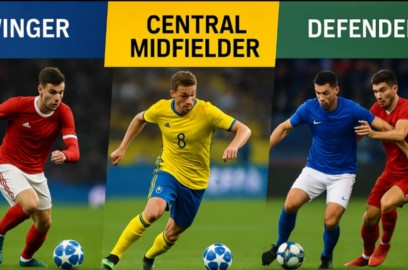
Many young players train in a general way – dribbling, strength, shooting – but forget one crucial fact: every position on the pitch requires different decisions, different movements, and a different understanding of the game. If you want to play like a professional, you must train not only your general skills but also the specific tactical behaviors of your position. This article gives you key insights and habits for each major area: defense, midfield, and attack – with a breakdown by role.
CENTRAL DEFENDER (CENTER BACK)
Your role: provide security, organize the backline, win duels, build up play from the back
Tactical tips:
-
Read the game – always watch the movement of strikers and possible through balls behind your line
-
Communicate loudly and clearly – you're responsible for the defensive structure
-
Don’t push out too far from the back line unless you have cover
-
Train your passing under pressure – modern center backs must be confident on the ball
FULL BACK
Your role: balance between defending and supporting the attack, creating width
Tactical tips:
-
Always think about your recovery when joining the attack – don’t leave your zone exposed
-
Work closely with your winger – create 2v1 overloads on the flank
-
Practice crossing on the move – it’s a key weapon from wide areas
-
Don’t ball-watch – always be aware of runners behind your back
CENTRAL MIDFIELDER (BOX-TO-BOX / DEFENSIVE)
Your role: link defense and attack, control the tempo of the game
Tactical tips:
-
Always be available – offer yourself for the ball and support the play
-
Switch the direction of play – look for open space on the wings
-
Stay disciplined in your positioning – don’t chase the ball
-
Practice passing under pressure and spatial awareness – you don’t have time in the middle
ATTACKING MIDFIELDER (NUMBER 10)
Your role: create chances, break lines, offer creativity
Tactical tips:
-
Always pass to your teammate’s strong foot – it speeds up the attack
-
Scan the pitch before receiving the ball – know your options in advance
-
Be dynamic – constantly look for pockets of space between the lines
-
Practice long shots and through balls – key tools for playmakers
WINGER
Your role: provide width, beat defenders, cross or cut inside to shoot
Tactical tips:
-
Change tempo and rhythm when dribbling – be unpredictable
-
Make quick decisions: dribble, pass or shoot – don't do all three at once
-
Observe the defender’s body position – attack their weaker foot
-
Don’t just stay wide – cut inside to create danger in central areas
STRIKER
Your role: score goals, press defenders, hold up the ball
Tactical tips:
-
Master movement without the ball – run behind defenders with good timing
-
Practice controlling and laying off the ball in one touch
-
Be alert for rebounds – many goals come from second balls
-
Don’t hide behind defenders – stay visible and accessible
WHAT’S COMMON FOR EVERY POSITION?
-
Open body positioning – see the whole pitch whenever possible
-
Make decisions before the ball reaches you
-
The game is played mostly with the head – intelligence beats athleticism
-
Your position is not a label – it comes with specific responsibilities
SUMMARY
Every position is a different world. If you truly want to become a professional, you must understand the tactical expectations of the role you play. Watch top players in your position, study their movements, train game-like behaviors, and learn how to play with your brain.
Want to go further? I can prepare tactical mini-guides for each position – with drills and real-game scenarios. Just let me know.





